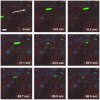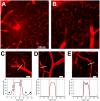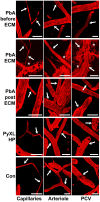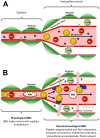Neuroimmunological blood brain barrier opening in experimental cerebral malaria
- PMID: 23133375
- PMCID: PMC3486917
- DOI: 10.1371/journal.ppat.1002982
Neuroimmunological blood brain barrier opening in experimental cerebral malaria
Abstract
Plasmodium falciparum malaria is responsible for nearly one million annual deaths worldwide. Because of the difficulty in monitoring the pathogenesis of cerebral malaria in humans, we conducted a study in various mouse models to better understand disease progression in experimental cerebral malaria (ECM). We compared the effect on the integrity of the blood brain barrier (BBB) and the histopathology of the brain of P. berghei ANKA, a known ECM model, P. berghei NK65, generally thought not to induce ECM, P. yoelii 17XL, originally reported to induce human cerebral malaria-like histopathology, and P. yoelii YM. As expected, P. berghei ANKA infection caused neurological signs, cerebral hemorrhages, and BBB dysfunction in CBA/CaJ and Swiss Webster mice, while Balb/c and A/J mice were resistant. Surprisingly, PbNK induced ECM in CBA/CaJ mice, while all other mice were resistant. P. yoelii 17XL and P. yoelii YM caused lethal hyperparasitemia in all mouse strains; histopathological alterations, BBB dysfunction, or neurological signs were not observed. Intravital imaging revealed that infected erythrocytes containing mature parasites passed slowly through capillaries making intimate contact with the endothelium, but did not arrest. Except for relatively rare microhemorrhages, mice with ECM presented no obvious histopathological alterations that would explain the widespread disruption of the BBB. Intravital imaging did reveal, however, that postcapillary venules, but not capillaries or arterioles, from mice with ECM, but not hyperparasitemia, exhibit platelet marginalization, extravascular fibrin deposition, CD14 expression, and extensive vascular leakage. Blockage of LFA-1 mediated cellular interactions prevented leukocyte adhesion, vascular leakage, neurological signs, and death from ECM. The endothelial barrier-stabilizing mediators imatinib and FTY720 inhibited vascular leakage and neurological signs and prolonged survival to ECM. Thus, it appears that neurological signs and coma in ECM are due to regulated opening of paracellular-junctional and transcellular-vesicular fluid transport pathways at the neuroimmunological BBB.
Conflict of interest statement
The authors have declared that no competing interests exist.
Figures











Similar articles
-
Experimental cerebral malaria pathogenesis--hemodynamics at the blood brain barrier.PLoS Pathog. 2014 Dec 4;10(12):e1004528. doi: 10.1371/journal.ppat.1004528. eCollection 2014 Dec. PLoS Pathog. 2014. PMID: 25474413 Free PMC article.
-
Endothelin-1 Treatment Induces an Experimental Cerebral Malaria-Like Syndrome in C57BL/6 Mice Infected with Plasmodium berghei NK65.Am J Pathol. 2016 Nov;186(11):2957-2969. doi: 10.1016/j.ajpath.2016.07.020. Epub 2016 Sep 15. Am J Pathol. 2016. PMID: 27640146 Free PMC article.
-
Extracellular vesicles derived from plasmodium-infected red blood cells alleviate cerebral malaria in plasmodium berghei ANKA-infected C57BL/6J mice.Int Immunopharmacol. 2024 May 10;132:111982. doi: 10.1016/j.intimp.2024.111982. Epub 2024 Apr 3. Int Immunopharmacol. 2024. PMID: 38569430
-
Cerebral malaria: mysteries at the blood-brain barrier.Virulence. 2012 Mar-Apr;3(2):193-201. doi: 10.4161/viru.19013. Epub 2012 Mar 1. Virulence. 2012. PMID: 22460644 Free PMC article. Review.
-
Mouse models of blood-stage malaria infections: immune responses and cytokines involved in protection and pathology.Chem Immunol. 2002;80:204-28. doi: 10.1159/000058845. Chem Immunol. 2002. PMID: 12058640 Review. No abstract available.
Cited by
-
Pharmacologic inhibition of CXCL10 in combination with anti-malarial therapy eliminates mortality associated with murine model of cerebral malaria.PLoS One. 2013 Apr 5;8(4):e60898. doi: 10.1371/journal.pone.0060898. Print 2013. PLoS One. 2013. PMID: 23630573 Free PMC article.
-
Investigation of hydrogen sulfide gas as a treatment against P. falciparum, murine cerebral malaria, and the importance of thiolation state in the development of cerebral malaria.PLoS One. 2013;8(3):e59271. doi: 10.1371/journal.pone.0059271. Epub 2013 Mar 26. PLoS One. 2013. PMID: 23555646 Free PMC article.
-
FTY720 restores endothelial cell permeability induced by malaria sera.Sci Rep. 2018 Jul 19;8(1):10959. doi: 10.1038/s41598-018-28536-1. Sci Rep. 2018. PMID: 30026484 Free PMC article.
-
PPARγ agonists improve survival and neurocognitive outcomes in experimental cerebral malaria and induce neuroprotective pathways in human malaria.PLoS Pathog. 2014 Mar 6;10(3):e1003980. doi: 10.1371/journal.ppat.1003980. eCollection 2014 Mar. PLoS Pathog. 2014. PMID: 24603727 Free PMC article.
-
Balancing in a black box: Potential immunomodulatory roles for TGF-β signaling during blood-stage malaria.Virulence. 2020 Dec;11(1):159-169. doi: 10.1080/21505594.2020.1726569. Virulence. 2020. PMID: 32043415 Free PMC article. Review.
References
-
- Rogerson SJ, Grau GE, Hunt NH (2004) The microcirculation in severe malaria. Microcirculation 11: 559–576. - PubMed
-
- Newton CR, Taylor TE, Whitten RO (1998) Pathophysiology of fatal falciparum malaria in African children. Am J Trop Med Hyg 58: 673–683. - PubMed
-
- WHO (2000) Severe falciparum malaria. World Health Organization, Communicable Diseases Cluster. Trans R Soc Trop Med Hyg 94 Suppl 1: S1–90. - PubMed
-
- Haldar K, Murphy SC, Milner DA, Taylor TE (2007) Malaria: mechanisms of erythrocytic infection and pathological correlates of severe disease. Annu Rev Pathol 2: 217–249. - PubMed
Publication types
MeSH terms
Substances
Grants and funding
LinkOut - more resources
Full Text Sources
Other Literature Sources
Research Materials

